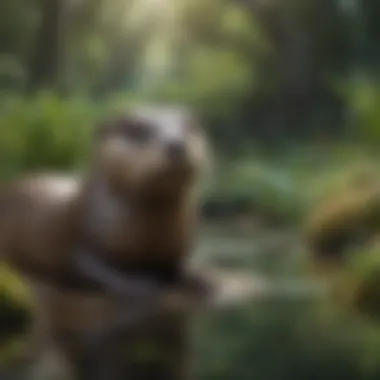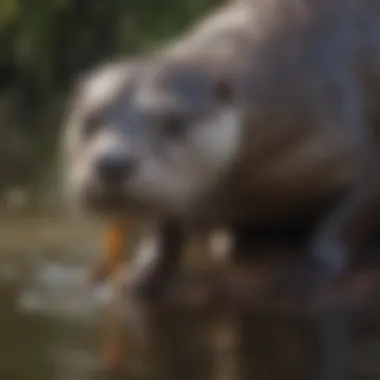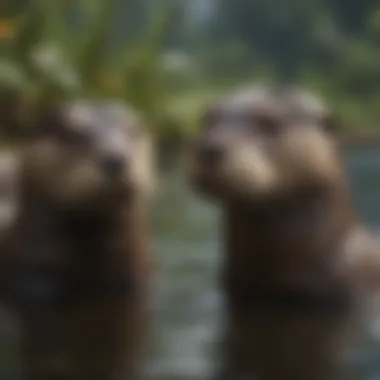Unveiling the Enigmatic World of Freshwater Otters: A Dive into Their Habitat and Behavior


Nature Topic Overview
Fun Facts and Trivia
Delving into the realm of freshwater otters unveils a host of intriguing facts and trivia that pique the curiosity of young minds. Did you know otters can hold their breath underwater for up to eight minutes, gracefully gliding through rivers and streams in search of food? Visual aids and interactive elements enhance the learning experience, offering a glimpse into the captivating world of these aquatic marvels.
Wildlife Explorations
Within the spectrum of wildlife explorations, freshwater otters stand out as charismatic inhabitants of water bodies worldwide. Diving deeper into their world unveils different otter species, each adapted uniquely to its specific habitat. Fascinating facts about these animals and their interaction with plants in their environment provide a nuanced understanding of the delicate ecological balance at play. Engaging quizzes and puzzles further entice exploration into the realm of otters and their surroundings.
Environmental Awareness
The role of freshwater otters in the ecosystem underscores the importance of conservation and sustainability efforts. Children are enlightened on the significance of protecting these creatures and their habitats to maintain biodiversity and ecological harmony. Practical tips empower young learners to take action in safeguarding nature, instilling a sense of environmental responsibility from an early age.
DIY Nature Activities
Incorporating hands-on activities and experiments into the narrative, children are encouraged to immerse themselves in the world of freshwater otters through creative endeavors. Step-by-step guides for nature-inspired crafts and projects enable kids to channel their newfound knowledge into tangible expressions of art and learning. Suggestions for outdoor explorations align with educational objectives, bridging theoretical understanding with practical applications in nature's vast classroom.
Introduction to Freshwater Otters
In this article, we embark on a fascinating journey through the world of freshwater otters, shedding light on their habitat, behavior, and ecological significance. The enigmatic nature of these creatures captivates the curiosity of nature enthusiasts and young minds alike, making them a subject of immense interest. By exploring the characteristics, evolutionary history, and interaction with humans, we aim to unravel the mysteries surrounding freshwater otters.
Defining Freshwater Otters
Characteristics and Species
The realm of freshwater otters is characterized by their sleek, streamlined bodies that glide effortlessly through water. Their furry coats, impeccably adapted for both land and aquatic life, make them stand out among mammals. With webbed feet facilitating swift swimming and hunting, freshwater otters are a marvel of evolution. Their playful nature and inquisitive behavior add to their charm, making them a popular choice for study and admiration in the realm of wildlife.


Habitat and Distribution
Freshwater otters predominantly inhabit rivers, streams, and lakes, showcasing their adaptability to diverse aquatic environments. From the icy waters of the Himalayas to the lush Amazon rainforests, these creatures carve a niche for themselves worldwide. Their distribution reflects not only their resilience but also the interconnectedness of ecosystems where they thrive. Despite facing challenges in the form of habitat degradation, freshwater otters continue to persist, underscoring their vital role in the aquatic landscape.
Evolutionary History
Ancestor Species
Tracing back the lineage of freshwater otters unveils a story of adaptive radiation and speciation. Their ancestors, dating back millions of years, exemplify the evolutionary transitions that culminated in the graceful swimmers we recognize today. Unique skeletal features and dental adaptations provide insights into the lifestyles of these ancient otters, shedding light on their evolutionary trajectory.
Adaptations for Aquatic Life
The seamless transition to aquatic life by freshwater otters is a testament to their exceptional adaptations. From insulating fur that maintains body temperature in water to retractable claws for efficient swimming, every aspect of their anatomy reflects the precision of evolution. Adaptations such as transparent eyelids for underwater vision and sensitive whiskers for detecting prey showcase the intricate web of evolutionary changes that culminated in the proficient aquatic hunters we observe today.
Behavioral Insights of Freshwater Otters
Delving into the world of freshwater otters, it is imperative to unravel their behavioral intricacies. The behavior of these aquatic creatures holds significant relevance in understanding their adaptation to their environment and interactions within their communities. One of the key elements to explore in this section is the social structure of freshwater otters, shedding light on how they organize themselves and communicate effectively. By examining their feeding patterns and reproductive behaviors, we can gain a holistic view of how freshwater otters navigate their existence.
Social Structure
Family Units
In the intricate tapestry of freshwater otters' social structure, the concept of family units stands out as a cornerstone of their community dynamics. The formation of family units among freshwater otters plays a crucial role in supporting their survival and enhancing their social bonds. A notable characteristic of family units is the collaborative effort in hunting and protecting their territory, which ultimately benefits the entire group. The unique feature of family units lies in the seamless coordination among members, whether in hunting for prey or defending against threats, showcasing the advantages of cooperative behavior in the otters' lifestyle.
Communication Methods
Communication methods among freshwater otters serve as a vital tool for maintaining cohesion within their social groups. Through a rich repertoire of vocalizations and body language, otters convey essential information about food sources, potential dangers, and group coordination. The key characteristic of their communication lies in its nuanced nature, enabling precise exchanges that contribute to the group's efficiency and unity. While the advantages of effective communication are evident in facilitating successful group activities, potential disadvantages may arise from misunderstandings or misinterpretations that could impact collaborative efforts negatively.
Feeding Patterns


Dietary Preferences
Examining the dietary preferences of freshwater otters unveils insights into their nutritional needs and ecological role within their habitat. Their selection of food sources reflects a balance between energy requirements and prey availability, influencing their foraging behaviors. The key characteristic of otters' dietary preferences lies in their adaptability to various aquatic organisms, showcasing a versatile approach to obtaining sustenance. This adaptability proves beneficial, especially in dynamic environments where food sources fluctuate, although certain disadvantages may arise from potential competition or predation risks.
Hunting Techniques
The hunting techniques employed by freshwater otters are a testament to their agility and strategic prowess in capturing prey. By observing their methods of stalking, chasing, and diving, one can appreciate the efficiency with which otters secure their meals. The key characteristic of their hunting techniques lies in the integration of speed, stealth, and precision, enabling them to excel in aquatic hunting scenarios. While these techniques offer advantages in securing food resources, potential disadvantages may surface in situations where prey availability is limited, necessitating adaptability in hunting strategies.
Reproduction and Offspring
Mating Behavior
Exploring the mating behavior of freshwater otters provides a glimpse into their reproductive strategies and social interactions. The distinctive courtship rituals and mate selection processes underscore the importance of breeding success in maintaining otter populations. The key characteristic of otters' mating behavior lies in the establishment of pair bonds and mating season synchrony, enhancing breeding efficiency and offspring survival rates. This unique feature fosters reproductive success but may pose disadvantages in terms of competition for mates and resources within the population.
Parental Care
Parental care among freshwater otters showcases a nurturing approach to raising offspring and ensuring their survival in challenging environments. The devoted parental behaviors, including grooming, protection, and teaching essential skills, contribute significantly to the young otters' development and well-being. The key characteristic of parental care lies in the investment of time and resources to support offspring growth, indicating a strong parental commitment within otter families. While this care promotes offspring resilience and survival, potential disadvantages may arise from parental conflicts or resource limitations impacting the parental investment.
Ecological Importance of Freshwater Otters
Freshwater otters play a crucial role in the ecosystems they inhabit. As keystone species, they have a significant impact on maintaining biodiversity and the overall health of aquatic communities. Their presence helps regulate populations of various species, preventing overpopulation of certain animals that could disrupt the delicate balance of the ecosystem. Additionally, otters are indicators of environmental health, as their population numbers and behavior reflect the quality of the water and surrounding habitats. By studying freshwater otters, researchers can gain valuable insights into ecosystem dynamics and make informed conservation decisions.
Keystone Species
In the context of this article, freshwater otters serve as keystone species due to their essential role in balancing aquatic ecosystems. The key characteristic of a keystone species is its disproportionate influence on the environment relative to its abundance. Otters, through their feeding habits and interactions with other species, help maintain the diversity and stability of their habitats. Their presence ensures the health of fish populations, controls invertebrate numbers, and even influences plant growth along water bodies. Without otters, these ecosystems would face imbalances that could cascade through the entire food chain.
Impact on Aquatic Communities
The impact of freshwater otters on aquatic communities is far-reaching. By controlling prey species such as fish and crustaceans, otters help regulate population sizes and prevent certain species from dominating the ecosystem. This predation pressure creates a more balanced and diverse environment, benefiting not only otters but also a myriad of other organisms that share the same habitats. Furthermore, otters' activities, such as digging dens along riverbanks, contribute to the physical structure of the ecosystem. These modifications create microhabitats for various species, enhancing overall biodiversity and ecosystem resilience.


Conservation Status
Due to various threats and challenges, the conservation status of freshwater otters remains a point of concern for environmentalists and conservationists globally. Habitat loss, water pollution, poaching, and conflicts with human activities pose significant risks to otter populations. These threats not only impact otters directly but also reverberate through the entire ecosystem, affecting biodiversity and ecological balance. Conservation initiatives are essential to address these challenges and ensure the long-term survival of these charismatic creatures.
Threats and Challenges
Threats such as habitat destruction, pollution, climate change, and illegal poaching collectively endanger freshwater otters worldwide. Habitat loss due to urbanization and agricultural expansion fragments otter habitats, isolating populations and reducing genetic diversity. Water pollution from industrial runoff and agricultural chemicals contaminates otter habitats, impacting not only their health but also that of the entire ecosystem. Illegal hunting and trading of otters for their fur or body parts further decimate already vulnerable populations.
Conservation Efforts
Conservation efforts play a vital role in safeguarding freshwater otters and their habitats. Organizations and governments worldwide are implementing various strategies to protect otter populations, including habitat restoration, pollution control measures, anti-poaching initiatives, and community engagement. By raising awareness about the importance of otters in the ecosystem and involving local communities in conservation projects, these efforts aim to mitigate threats and ensure a sustainable future for these remarkable animals. Collaborative conservation actions are essential to secure the well-being of otters and the health of their surrounding environments.
Interaction with Humans
In this compelling section, we unravel the intricate relationship between freshwater otters and humans. The interaction with humans holds paramount importance in understanding the dynamics of conservation efforts and ecological balance. By examining how human activities impact otter habitats and behaviors, we can glean valuable insights into sustainability and coexistence. This segment delves into the various facets of otter-human interaction, shedding light on the challenges, benefits, and mitigation strategies essential for fostering harmonious relationships.
Cultural Significance
Mythology and Folklore
The realm of mythology and folklore encapsulates a rich tapestry of narratives woven around freshwater otters. These mythical tales often portray otters as symbols of playfulness, agility, and wisdom in diverse cultures worldwide. By exploring the unique myths and folklore surrounding otters, we gain a deeper appreciation for the cultural significance these creatures hold. This exploration serves as a portal to understanding how ancient beliefs and stories have shaped our perception of otters and their intrinsic connection to human imagination.
Symbolism in Different Cultures
Across different cultures, the symbolism attributed to freshwater otters varies, reflecting the multifaceted nature of human-animal relationships. Whether revered as spirit guides, protectors of rivers, or symbols of adaptability, otters symbolize resilience and interconnectedness in a rapidly changing world. By delving into the symbolism of otters across diverse cultural landscapes, we unravel the intricate threads that bind human societies with the natural world, offering profound insights into the universal language of symbolism and its enduring resonance.
Human-Wildlife Conflict
Challenges in Coexistence
Navigating the complex terrain of human-wildlife conflict poses challenges that demand careful consideration and proactive solutions. The coexistence of humans and otters often faces hurdles like habitat loss, competition for resources, and conflicts arising from diverse perspectives on conservation and development. By dissecting the inherent challenges in fostering harmonious coexistence, we unravel the complexities that underlie sustainable wildlife management and the preservation of biodiversity.
Mitigation Strategies
Amidst the myriad challenges of human-wildlife conflict, the implementation of effective mitigation strategies emerges as a vital beacon of hope. From habitat restoration and community education to policy interventions and stakeholder engagement, these strategies offer a roadmap towards harmonizing human activities with the conservation of otter populations. By exploring the nuances of mitigation strategies, we envision a future where proactive measures lead to transformative change, ensuring the continued existence of freshwater otters amidst evolving landscapes.







